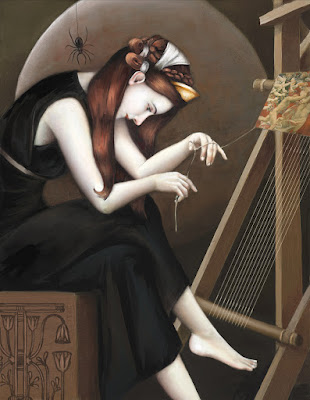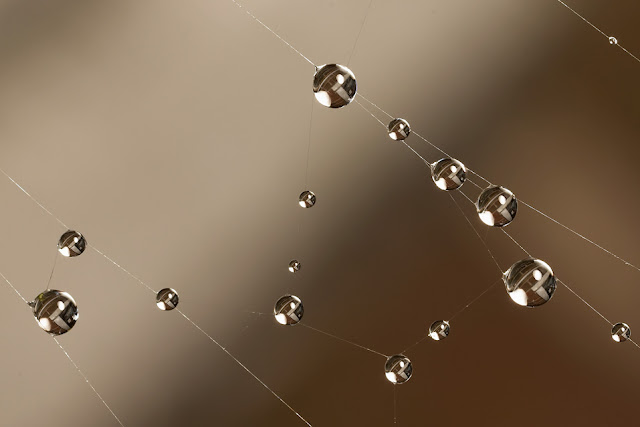Of course Nature is our first teacher. How could it be otherwise? We copy her handiwork, infusing it with our own human aesthetics, and this fuels the matrix we call 'culture'.
It has been the provenance of women to apply decorative arts to ordinary objects used in daily life, because we love and require beauty. If I have to look at the same clay pot everyday, by golly, it needs to be beautiful. Anything mundane can be elevated by decoration, applied to bring harmony and self-expression into the standard tasks of survival.
Beyond the basics of food, clothes, and shelter, we expand into the cosmological function of design, the sacred patterns used ceremonially to honor specific milestones in human life, to identify one's rank or function (whether Queen, Midwife, Cook, or Shaman), or to honor the Divine.
Do you knit? Do you crochet, or do bead work? Are you a weaver? If you do any of these, you know the importance of math in the protocols of fabric. All the stitches must be counted to maintain the integrity of the pattern. Spider Grandmother seems a perfect mentor for these skills, as she is simultaneously an architect, an engineer, and an artist.
She knows how to catch her own dinner, which is occasionally just some poor suitor attempting to impress her. Cannibalism is an unfortunate potential by-product of courtship in the spider dating scene.
Still, Grandmother Spider retains her popularity in many cultures. Hopi, Navajo, Choctaw, the Ojibway, the Zuni - all have specific cultural gifts that are said to have come from her. She is described as a helper of the people. The style of her webs inspired the female relatives to weave Dream-catchers, to catch and filter out the bad dreams of infants, so that only good thoughts are allowed to enter.
 |
| Spider Grandmother is honored in the Nazca lines of Peru. |
We find Spider-Lore among the Greeks too. Ariadne, the Cretan lass who couldn't catch a break, eventually ended up married to Dionysus, the town drunk of Mount Olympus. But she also had the spidery strategy to help Theseus, giving him a thread to unroll as he entered the labyrinth, so he could find his way out after slaying the Minotaur. She then ran off with him, but Theseus abandoned her on the island of Naxos. At that point we might say he went from Cretan to cretin.
 |
| image by Thalia Took |
Then there is the tale of Arachne, a weaver so renowned that a whole class of anthropoids is named after her.
 |
| Haeckel Arichnida, Wikipedia |
Her consummate mastery of the loom aroused the attention of Athena, the favorite daughter of Zeus. So sure of herself was Arachne that she vowed her willingness to compete in a contest of skill with this immortal competitor.
Athena, you may remember, sprang fully grown from her father's forehead (signaling the predominance of intellect over the intelligence of the heart). Like Sekhmet, who was sent by her father Ra to extract revenge for human offenses, these goddess patterns have personas that are actually more male than female. They are the 'Daddy's girl', their "father's daughters", competitive by nature.
And, yes, even though Arachne's work was impeccable, her waft and weave described as "sheer magic and a sight to behold", her arrogance had to be answered. To correct this, Athena turned her into a spider.
Hardly a level playing field. It's so annoying the way some people exploit their super powers just because they can.
 |
| from The Digital Renaissance by Carlyn Beccia |
I hope, at least, that Arachne earned enough points to be transformed into a Peacock Spider. View this remarkable video of the male courtship ritual with your speakers on. Spiders have no ears, so their special language is a love song of drumming. And woe to the male who is not a good drummer. In spider marriages, 'consummation' takes on a whole new meaning.
The only male version I have seen of Spider energy exists among the Lakota, who perceive him as a shapeshifter called Iktomi. Similar to the Hopi Clown Kachinas, he dispenses moral lessons, particularly to youth, in ways that may be shocking or embarrassing. As a trickster figure, his behavior hovers somewhere in the ambiguous zone between right and wrong.
Getting back to our subject, let me declare that our skills with numbers are legend. Drawing on the mythological records, we find a plethora of goddess credited with having created mathematics. To support that, here are the entries from a few celestial pantheons:
Sarasvati: She is said to have invented all the arts of civilization: music, mathematics, calendars, magic, letters, and all other branches of learning.
Mensa - Goddess of Measurement, numbers, calendars, calculations, tables and record keeping.
Seshat - Egyptian Mistress of the House of Books, the Goddess of writing, history, measurements, calculation, record keeping and architecture. Goddess of Hieroglyphics. Lady of the Builder's Measure.
Savitri - Hindu Mother of Civilization, She Who brought forth music and literature, rhythm, time, measurements, day and night, memory, conquest, victory and yoga.
Unelanuhi: In indigenous cultures, spirits exist in all phenomenon of nature, such as the wind, the storm, the clouds. All can be called upon for aid.
In Cherokee culture we find Nuda Unelanuhi (Apportioner/Sun), and Nuda Geyaguga (Woman Measurer /Moon), functioning as both messengers and helper spirits.
The Cherokee word for Calendar -- nv-do di-se-s-di -- translates as "moon counter". Unelanuhi's name means 'Apportioner', for she is responsible for having divided time into units.
This is no coincidence. This is how our history was kept. It's not for nothing we became known as Calculating Women. We earned it.
And while we learnt a great deal from Grandmother Spider, her abacus was not our only source. The moon also taught us math. It was from watching her that we became Unelanuhi.
For instance, this girl has her calendar in her hand. On that crescent horn, 13 notches are carved, indicating the naturally occurring lunations in a year. A lunation = one complete cycle of moon phases = the synodic month (29.5 days) rather than the sidereal month (27.3 days).
So here it is, the original 'app' for tracking a pregnancy to term.
Not available on I-Tunes.
Not available on I-Tunes.
Given the name, "The Venus of Laussel", she was discovered in a cave in southwestern France in 1911, but she'd already been standing there for 25,000 years, still bearing traces of the red ochre with which she was painted. That she is tracking her pregnancy is fairly obvious, and this IS the urgent survival need that engendered the lunar/menstrual calendar. Even in the Stone Age, one wants to be prepared, for birth is a life or death proposition.
Animal mothers, just like human beings, may die in the process of birthing their young. But because they do not know of this possible outcome, they have no need for courage. Courage can only be summoned in response to a clear danger. Of all animals who labor in birth, only the human woman approaches the birthing process with the consciousness that her own death may be required.
A woman about to give birth stands at the gateway between death and life. She peers into the death realm, not knowing for certain if she will come out alive, and she reaches over there to bring through another new soul.
-- Vicki Noble, Shakti Woman
 |
| My first encounter with this image described it as the Aztec goddess Tlazolteotl giving birth to CORN, which is considered to be the Mother of the People. The true origins of this sculpture are disputed among scholars. Tlazo displayed at Dumbarton Oaks. |
Some of our moon-counting tools are even older than Ms. Laussel. The Lebombo bone is estimated at 35,000 - 37,000 years old, and was found in the mountains between South Africa and Swaziland.
It was necessary to prepare: we would be gone for close to a week. We had to bring enough food to last us the journey, including preparing food to leave behind for the elders who were watching the children.
Almost sounds like a nice monthly vacation, doesn't it? Maybe we should seriously consider reinstating that practice!
But, you might ask, why did we go away to the Lodge?
There were at least 3 good reasons.
One is simply hygienic. This is a messy business and we don't want that all over the house. Who do you think has to clean it up? Give us a moment to invent indoor plumbing.
But, hey, after surviving childbirth, we aren't to be scared off by a few hyenas. I imagine that a cave was the perfect Lodge, easily defend-able with our superior technology, which we call fire.
So that is the second reason: we transfer the danger to ourselves for the safety of others, which remains a courage characteristic to women. Men are also capable of this.
The female DNA commands our primary mission, which is to Keep Life Alive. This applies whether it's an ailing house plant, a baby bird that fell from the nest, or an orphaned child of any species. If it is alive, we try to keep it that way. This is our inherent genetic obligation to life.
Only men need worry about being 'pro-life' -- we're already hard-wired for that. I'd advise them to go practice their drumming, as it is my duty to point out that in the model demonstrated by our animal relatives, the needs of the living outweigh those of the unborn. Animals do not reproduce another baby until the first one can fend for itself. That's just the way it is. Nature knows more than we do.
However, we do have an advantage peculiar only to humans: elders. In contrast to other animals, we live long past our ability to reproduce. This means we needn't wait for baby #1 to graduate college before we have another. Grandma will babysit while we go to work.
And the third reason: from out of the Lodge came The Council of Women. In that gender camp, business got handled. The needs of the community were sorted. Societal balance was maintained.
So we return at last to Africa, where Grandmother Spider is known as Anansi. One story goes that she took a web she had spun, laced it with dew, threw it into the sky and the dew became the stars. Her web construction illustrates how, as humans, we should be linked together to build our society.
What if we would truly see ourselves as balls of light-reflecting water, connected to each other by a web of flexible filaments?
 photo by Brian Valentine
photo by Brian Valentine
This might be the most important lesson we could take from Grandmother Spider. We would then access the World Wide Web from the inside. No need for a computer.
Who taught Grandmother Spider how to weave this silken thread that rivals the tensile strength of steel?
I hear she studied at the Uni Verse City of Fibonacci,
Who taught Grandmother Spider how to weave this silken thread that rivals the tensile strength of steel?
I hear she studied at the Uni Verse City of Fibonacci,
learning that perfect math by which
the organic universe is spun into existence.
the organic universe is spun into existence.
May all your dreams be protected.
Ms. Kiva's Mom







